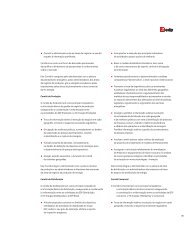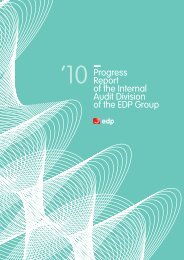Annual Report - EDP
Annual Report - EDP
Annual Report - EDP
- No tags were found...
Create successful ePaper yourself
Turn your PDF publications into a flip-book with our unique Google optimized e-Paper software.
notes to the consolidated <strong>EDP</strong> - and Energias company de Portugal, financial S.A. statementsfor the Notes years to the ended Consolidated 31 december and Company 2012 Financial and Statements 2011for the years ended 31 December 2012 and 2011Sensitivity analysis - Interest rates (excluding the Brazilian operations)Based on the debt portfolio contracted by the Group, except for Brazil and the related derivative financial instruments used to hedge the related interest rate risk, a 100basis points change in the reference interest rates at 31 December 2012 and 2011 would lead to the following increases / (decreases) in equity and results of the <strong>EDP</strong>Group:Dec 2012ResultsEquity100 bp 100 bp 100 bp 100 bpThousands of Euros increase decrease increase decreaseCash flow effect:Hedged debt -20,121 20,121 - -Unhedged debt -83,238 83,238 - -Fair value effect:Cash flow hedging derivatives - - 53,985 -59,599Trading derivatives (accounting perspective) -4,016 1,355 - --107,375 104,714 53,985 -59,599Dec 2011ResultsEquity100 bp 100 bp 100 bp 100 bpThousands of Euros increase decrease increase decreaseCash flow effect:Hedged debt -19,082 19,082 - -Unhedged debt -66,160 66,160 - -Fair value effect:Cash flow hedging derivatives - - 47,501 -51,429Trading derivatives (accounting perspective) -7,884 4,658 - --93,126 89,900 47,501 -51,429This analysis assumes that all other variables, namely exchange rates, remain unchanged.Counterparty credit risk managementThe <strong>EDP</strong> Group’s policy in terms of counterparty risk on financial transactions is managed through an analysis of the technical capacity, competitiveness, credit ratingand exposure to each counterparty, avoiding significant concentrations of credit risk. Counterparties in derivative financial instruments are credit institutions with highcredit risk rating notation and therefore the risk of counterparty default is not considered to be significant. Guarantees and other collaterals are not required on thesetransactions.The <strong>EDP</strong> Group has documented its financial operations in accordance with international standards. Therefore, generally, derivative financial instruments arecontracted under ISDA Master Agreements.Regarding the third-party debt generated by the Group’s day-to-day business, the credit risk arises essentially from the legal obligation of providing continuous lowtensionelectricity supplies even when there are payment delays. This risk is considered to be mitigated by the large number of customers and by their diversity interms of sectors of activity, as well as by the large volume of residential customers.<strong>EDP</strong> Group believes that the amount that best represents the Group's exposure to credit risk corresponds to the carrying amount of trade receivables and otherdebtors, net of the impairment losses recognised. The Group believes that the credit quality of these receivables is adequate and that no significant impaired creditsexists that have not been recognised as such and provided for.Liquidity risk managementThe <strong>EDP</strong> Group undertakes management of liquidity risk through the engagement and maintenance of credit lines and financing facilities with a firm underwritingcommitment with national and international financial institutions allowing immediate access to funds. These lines are used to complement and backup national andinternational commercial paper programmes, allowing the <strong>EDP</strong> Group’s short-term financing sources to be diversified (see note 35).Energy market risk managementIn its operations in the non-regulated Iberian electricity market, <strong>EDP</strong> Group purchases fuel to generate electric energy and sells the electric energy generated by itsplants in the organised market (OMEL and OMIP) as well as to third parties. The Group is exposed to energy market risks namely in its operations in the non-regulatedmarket. Some electricity generating plants despite operating in the market, are subject to the CMEC legislation, and the changes in the operating margins aredetermined essentially by the difference between the prices in the market and the reference indexes defined in the contracts.As a result of its energy management operations, <strong>EDP</strong> Group has a portfolio of operations related to electric energy, carbon emissions (CO2) and fuel (coal, fuel andgas). The portfolio is managed through the engagement of operations with financial and physical settlement on the forward energy markets. The objective of theoperations is to reduce volatility of the financial impact resulting from the managed positions and also to benefit from arbitration or positioning within the trading limitsapproved by the Executive Board of Directors. The financial instruments traded include swaps and forwards of electricity and fuels to fix prices.The activity of energy management is subject to a series of variables which are identified and classified based on their common uncertainty characteristics (or risk).Such risks include market price evolution risk (electricity and fuel) and hydroelectric production volume risk (price and volume risk), as well as credit risk of thecounterparties.192A World Full Of Energy
















